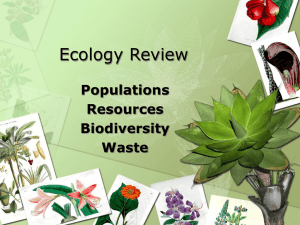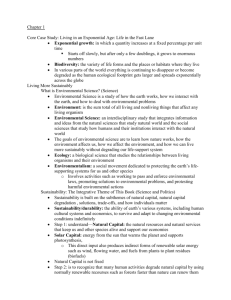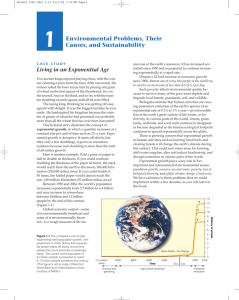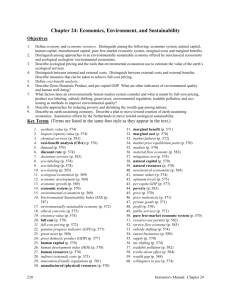Outline
advertisement
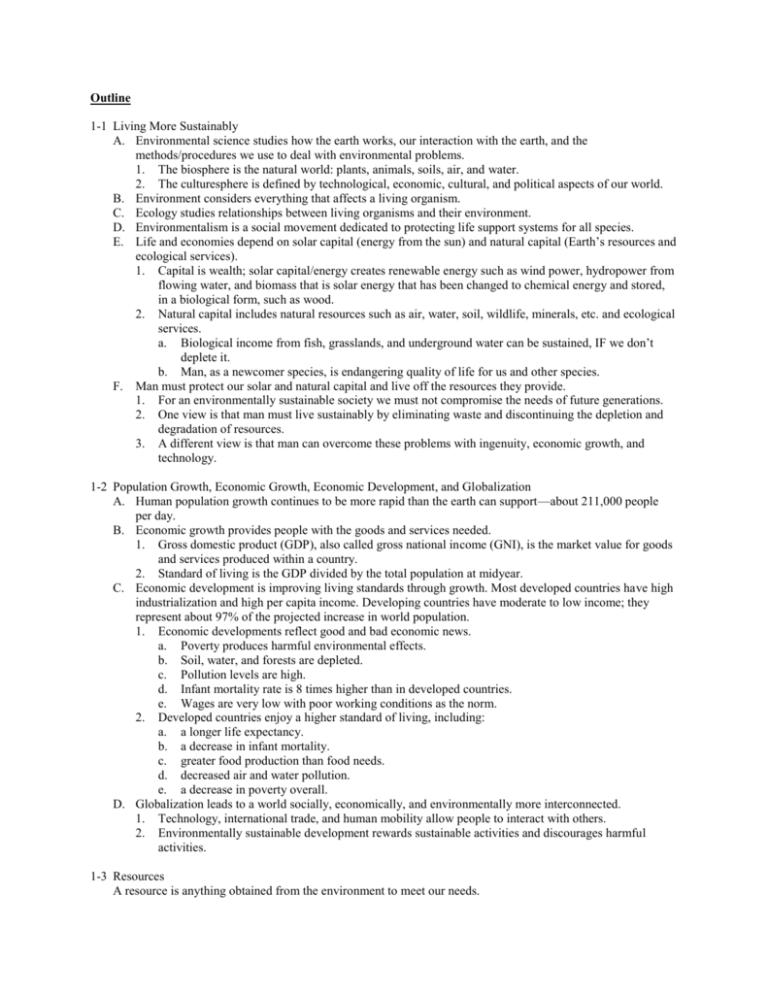
Outline 1-1 Living More Sustainably A. Environmental science studies how the earth works, our interaction with the earth, and the methods/procedures we use to deal with environmental problems. 1. The biosphere is the natural world: plants, animals, soils, air, and water. 2. The culturesphere is defined by technological, economic, cultural, and political aspects of our world. B. Environment considers everything that affects a living organism. C. Ecology studies relationships between living organisms and their environment. D. Environmentalism is a social movement dedicated to protecting life support systems for all species. E. Life and economies depend on solar capital (energy from the sun) and natural capital (Earth’s resources and ecological services). 1. Capital is wealth; solar capital/energy creates renewable energy such as wind power, hydropower from flowing water, and biomass that is solar energy that has been changed to chemical energy and stored, in a biological form, such as wood. 2. Natural capital includes natural resources such as air, water, soil, wildlife, minerals, etc. and ecological services. a. Biological income from fish, grasslands, and underground water can be sustained, IF we don’t deplete it. b. Man, as a newcomer species, is endangering quality of life for us and other species. F. Man must protect our solar and natural capital and live off the resources they provide. 1. For an environmentally sustainable society we must not compromise the needs of future generations. 2. One view is that man must live sustainably by eliminating waste and discontinuing the depletion and degradation of resources. 3. A different view is that man can overcome these problems with ingenuity, economic growth, and technology. 1-2 Population Growth, Economic Growth, Economic Development, and Globalization A. Human population growth continues to be more rapid than the earth can support—about 211,000 people per day. B. Economic growth provides people with the goods and services needed. 1. Gross domestic product (GDP), also called gross national income (GNI), is the market value for goods and services produced within a country. 2. Standard of living is the GDP divided by the total population at midyear. C. Economic development is improving living standards through growth. Most developed countries have high industrialization and high per capita income. Developing countries have moderate to low income; they represent about 97% of the projected increase in world population. 1. Economic developments reflect good and bad economic news. a. Poverty produces harmful environmental effects. b. Soil, water, and forests are depleted. c. Pollution levels are high. d. Infant mortality rate is 8 times higher than in developed countries. e. Wages are very low with poor working conditions as the norm. 2. Developed countries enjoy a higher standard of living, including: a. a longer life expectancy. b. a decrease in infant mortality. c. greater food production than food needs. d. decreased air and water pollution. e. a decrease in poverty overall. D. Globalization leads to a world socially, economically, and environmentally more interconnected. 1. Technology, international trade, and human mobility allow people to interact with others. 2. Environmentally sustainable development rewards sustainable activities and discourages harmful activities. 1-3 Resources A resource is anything obtained from the environment to meet our needs. A. Natural capital/natural resources are those in the environment or those obtained from the environment: food, water, air, shelter, petroleum, etc. B. Natural resources are classified as perpetual, renewable, or nonrenewable. 1. A perpetual resource is renewed continuously, like solar energy. 2. Renewable resources must not be used up faster than they are able to be replaced, like grasslands, fresh water and air, fertile soil, etc. 3. Sustainable yield is the highest rate of use on an indefinite scale without degradation or depletion. 4. Environmental degradation occurs when the use of resources exceeds the rate of replacement. C. The Tragedy of the Commons describes the overuse or degradation of freely available resources such as ocean pollution, abuse of national parks, air pollution, etc. No one individual owns these free-access resources. 1. Limiting access to these resources is one possible way to protect them. 2. Reducing the population might also allow these resources to be used below estimated sustainable yields. 3. Converting free-access resources to private ownership is another possible means to protect them. a. Private owners may not actually protect the resources. b. Global resources such as oceans, air, and migratory birds cannot be divided up and made private property. c. Access to the resources is eliminated/reduced for many people. 4. Governments have laws and treaties that regulate access to commonly owned resources. D. What is our ecological footprint, our impact on the environment? 1. The per capita ecological footprint is the biologically productive land and water needed to supply renewable resources and absorb waste for each individual. 2. Currently, each person’s ecological footprint is 20% greater than can be sustained indefinitely. As a result, we have polluted air and water, waste overload, poorer health, less biodiversity, etc. 3. We need four more planet Earths to meet the consumption levels of the U.S. E. What are nonrenewable resources? 1. Nonrenewable resources are those that exist in fixed quantity or stock in the earth’s crust. The resource is economically depleted when it costs too much to obtain what is left. 2. These include energy resources (oil, coal, natural gas, etc.), metallic mineral resources (copper, iron, aluminum, etc.), and nonmetallic minerals (salt, clay, sand, phosphates, etc.). 3. There are solutions for an economically depleted resource, which include: a. trying to find more of the resource. b. recycling the resource and buying products made from recycled material, or reusing the resource in the same form. c. wasting less. d. using less. e. trying to develop a substitute for the resource. f. waiting millions of years for more to be produced. 1-4 Pollution Pollutants are chemicals at high enough levels in the environment to harm people or other living organisms. A. Where do pollutants come from, and what are their harmful effects? 1. Pollutants may enter the environment naturally (for example, volcanic eruptions) or through human activities such as burning coal; pollution tends to occur in or near urban and industrial areas. 2. Point sources of pollutants are single, identifiable sources, such as automobiles or industrial plants. They are easier to identify and control than non-point sources. 3. Non-point sources are dispersed, such as pesticides in the air and water runoff. They are difficult to identify. a. Pesticides sprayed into the air may be carried from their source. b. Fertilizer runoff enters streams away from the source. 4. Three unwanted effects of pollutants: a. They can disrupt or degrade life-support systems of any organism. b. They damage human health, wildlife, and property. c. They can produce nuisances in noise, smells, tastes, and sights. B. Solutions: What can we do about pollution? 1. We use two basic approaches to deal with pollution. a. Pollution prevention/input pollution control reduces or eliminates the production of pollutants. b. Pollution cleanup/output pollution control cleans up or dilutes pollutants after they have been produced. c. Problems with pollution clean up: 1) It is a temporary bandage without long-term pollution control technology (like the catalytic converter). 2) The pollutant is removed but may cause pollution in another place (for example, burning garbage/burying it). 3) It is expensive to reduce pollution to an acceptable level. Prevention is less expensive in the long run. 1-5 Environmental and Resource Problems: Causes and Connections A. Six major causes of environmental problems: 1. Population growth 2. Wasteful resource use 3. Poverty a. The focus is on survival at the expense of forests, soil, grasslands, and wildlife. b. People live in areas with a greater risk of natural disasters. c. People generally work in unsafe and unhealthy conditions for low wages. d. Life expectancy is reduced. e. There are no government-sponsored health plans or retirement plans. f. People die from preventable causes (malnutrition, normally nonfatal infectious diseases, lack of clean drinking water, and respiratory problems). 4. Bad environmental accounting 5. Ecological ignorance 6. An inadequate understanding of how the earth works B. Affluence is the addiction to over-consumption of material goods. 1. Symptoms include high debt level, declining health, increased stress, and more bankruptcies. 2. Solutions include admitting the problem, shopping less, and avoiding malls and other shopping addicts. 3. Toynbee’s law of progressive simplification: transfer energy and attention to the nonmaterial side of life. C. Affluence of developed countries can lead to environmental improvements. 1. Money is available for technological improvements. 2. Compared to 1970, air and water are cleaner. 3. Money was spent on environmental improvements. D. Environmental quality is affected by interactions between population size, resource consumption, and technology. 1. Environmental impact (I) depends on the number of people (P), average resource use/person (Affluence), and the beneficial and harmful effects of technologies (T) used to provide/consume each unit of resource. 2. Developing countries have large populations that result in degradation of renewable resources. 3. Developed countries have high per capita consumption (U.S. use 35–100 times more than other countries). 4. Some forms of technology are environmentally harmful, others are environmentally beneficial. 1-6 Is Our Present Course Sustainable? A. Environmental news centers on improvements in the quality of life and protecting the environment. But, there are many serious problems not addressed and/or ignored. B. If degradation of the environment is not halted, sustainable development is not possible. 1. The technological optimists tell us not to worry. 2. Environmental pessimists see the problem as hopeless. C. Present and future environmental problems: 1. Poverty and malnutrition—biggest threats 2. Smoking and air pollution 3. AIDS 4. Climate change and water shortages 5. Decrease in biodiversity 6. Earth’s natural capital will be degraded so that living organisms are at even greater risks. D. Most serious environmental risks in terms of people: 1. Biodiversity loss and climate change 2. Same as in C above E. To live more sustainably, we must: 1. identify how the earth has sustained itself. 2. apply this information to our lifestyles and economies. 2. use economic rewards to encourage more sustainable forms of economic growth. 3. use economic penalties to discourage unsustainable forms of economic growth. F. Change comes from dedicated, committed people; 5–10% of a population can bring major social change. G. Guidelines for working with the earth: 1. Never leave the earth worse than you found it. 2. Take only what you need. 3. Do no harm. 4. Sustain diverse living organisms. 5. Maintain earth’s capacity for self-repair and adaptation. 6. Do not waste; do not pollute. 7. Decrease population; reduce poverty.


